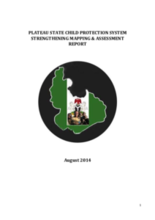CHAPTER ONE: INTRODUCTION
In line with the global trend of developing and strengthening a viable Child Protection System (CPS), the Nigerian Government through the Federal Ministry of Women Affairs and Social Development embarked on a mapping and assessment of its existing Child Protection system structures. The Federal Government in 2010 together with the Lagos State Government embarked on a pilot test to map and assess the existing components of Child Protection in Lagos and Child Frontiers was recruited to undertake the mapping and assessment. The pilot test was completed in 2013 and based on the success recorded, the mapping and assessment exercise began in Abuja, the country’s Federal Capital Territory, Benue, Edo, Kaduna, Kano and Plateau States.
CapacityPlus (part of IntraHealth International) got the support of USAID to carry out the mapping and assessment in the six States mentioned above with UNICEF assisting technically. CapacityPlus worked with the Federal Ministry of Women Affairs and Social Development, the State MWASD of the five states and the Social Development Secretariat (a replica of the State MWASD in the FCT) and coordinated logistics and administration.
The mapping and assessment exercise in Plateau State was a rigorous process that brought together all Child Protection actors in the State. The following State Government Ministries, Departments and Agencies (MDAs) were part of the process: The Ministries of Women Affairs and Social Development, Education, Health, Finance, Justice, Plateau State; The State’s Emergency Management Agency, Planning Commission and Universal Basic Education Board. The following Federal Government MDAs and security agencies with Offices/Commands in the State were also actively involved in the process; Legal Aid Council, National Human Rights Commission-North Central Zone, National Population Commission, The Nigeria Police Force, Plateau State Command; The Nigeria Security and Civil Defence Corps, Plateau State Command, Nigeria Immigration Service and the Nigeria Prisons.
The Child Protection Network, Plateau State Chapter and other Child-Based Non Governmental Organizations were also part of the process. However, there were some organizations and agencies that were identified as relevant and invited for the series of programs held during the process but did not show interest.
The mapping team ensured that stakeholders understood the essence of the exercise as not being an audit but rather to identify gaps in the Child Protection system with the aim of addressing them, to ensure a proper running of the system which will result in meeting the protection needs of children in the State. This worked for the team as the stakeholders accepted the entire process seeing it as something that will be beneficial to them and will in the long run ease their work with regards to Child Protection. This can be said to be responsible for the honesty and transparency exhibited by stakeholders in the process of data collection.

